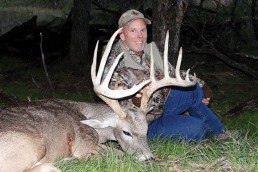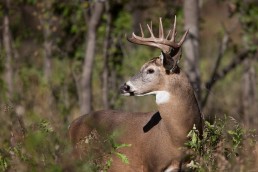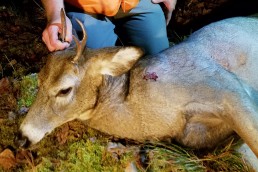A Spike Buck as good as a 10-Pointer
SHARE THIS POST
Spike buck or no buck?
Ordinarily, my sons, grandson and I hunt mature bucks only, not a spike buck. We limit ourselves to four deer annually. Usually, no more than one is a dominant breeding buck. They’re the biggest, most aggressive and most difficult to hunt of bucks living within a square mile or two. The rest are non-breeding bucks 2-1/2 to 6-1/2 years old. We limit ourselves to these deer for several reasons. For one, ever since we established our current hunting/study area in 1990, our deer numbers have been exceptionally low. We accurately determine our deer numbers each year by several means. Deer ranged between six per square mile in 2016 to 11 per square mile in 2000. That’s in a region that once supported 22 per square mile.
During this period, three severe winters reduced numbers by a third or more. The main deterrent to subsequent recoveries in deer numbers has been grey wolves. Since 1990, they have killed three out of every four fawns born in May by November 1. This is evident by deer hair, unworn/unstained fawn teeth and fawn-sized hooves and dewclaws in most wolf droppings all summer-long (never found in bear droppings). We thus decided we should not take does, the only deer that can improve our deer numbers. Due to our ongoing hunting-related research that began in 1970, we’ve become proficient enough to regularly pass up opportunities to take yearling and 2-1/2 year-old bucks. We have taken 97 mature bucks in this area since 1990. We intended to take our usual four again during our 2017 Minnesota firearm deer hunting season.
Winter wonderland
When I turned my four-wheel-drive pickup onto the forest road leading to our usual campsite, three miles south of the Canadian border and three days before the opener, snow was axle deep. Great numbers of trees heavily laden with wet, sticky snow leaned across the narrow trail. Snow fell heavily. At this point, we were pleased. It would be the first hunting season in many years with tracking snow on the ground. Snow makes it easier to key on mature bucks.
Mother Nature (La Niña, actually) had other plans. After shoveling snow from the patches of ground where we normally erect our two big wall tents, we cut and split wood. Enough firewood to warm the big tents and continuously melt the heavy, wet snow falling nonstop on our roofs. Throughout our time in camp, snow fell almost without pause. It only occasionally let up for a few hours. One evening cleared to reveal colorful northern lights above us. Meanwhile, it was necessary to set our alarm clocks to wake us every 3 or 4 hours. We had to keep our barrel stoves hot enough so that the tents wouldn’t collapse under the weight of accumulating snow.
Adrift in the drifts
Obviously, we’d need extra time to get to the stand sites we had selected a few weeks earlier. On opening morning, we were all on our way by 5 a.m. We soon discovered, however, that the woods had become a snowy hell. The fluorescent tacks we had placed on tree trunks to lead us to our stands had completely disappeared. Trails vanished amidst jungles of snow-covered brush and trees. Many trees were fallen or bent to the ground under hip-deep snow. Specimens as tall as 30 feet arched to the ground with snow pinning their upper branches to the forest floor. Tangles of hazels and other brush combined with fallen timber beneath the deep snow to make every step difficult and often hazardous.
The going was slow. Forced to make frequent detours, we were often unsure of our locations. Occasionally, our compasses told us we were actually traveling directly away from our destinations. Two and a half hours later, some of us had found our stand sites. Others hadn’t—me for one. At this point, I was too exhausted to take another step. After kicking away a patch of snow, I sat down on my stool right there. Not surprisingly, we saw very few tracks or deer that morning. Some of our group saw two does and one young spike buck that easily disappeared, unmolested. All hunters were hard-pressed to return to camp by noon that day. There we dried off, rested and considered what to do next.
“Anything with antlers”
“Under these unusual conditions, anything with antlers is acceptable,” we all agreed.
On Tuesday evening, however, the pole behind camp that normally would have held two or more bucks was still empty.
Are you enjoying this post?
You can be among the first to get the latest info on where to go, what to use and how to use it!
“Tomorrow morning,” my son John announced over dinner that evening, “I’m going break a trail to my favorite stand site on the back of the Moose Mountain whitetail feeding area. I know it will be tough to do, being two miles of rough going under the best of circumstances. All I want to do tomorrow is to get to my stand by first light when the wind direction will be favorable.”
John did not return to camp until two hours after sunset, that evening. He was completely exhausted and unsure he had actually found the last 100 yard section of the trail leading to his blind because of a myriad of fallen trees. Wednesday, John rested. By 4:30 Thursday morning, he was on his way, filled with high expectations.
Spike buck spotted
“Stopping behind the trees just to the right of my blind at sunup to make sure I was not seen by any deer, I immediately noticed a deer about 150 yards away staring directly at me,” John explained back in camp later that day. “I couldn’t tell if it had antlers, but it appeared large enough to be a mature buck. It turned and disappeared before I could check it out with my scope. About 11, I spotted a doe and fawn feeding on osiers on the high end of the feeding area on my right. After about 15 minutes passed, I noticed the spike buck. It was about 100 yards away, out in front of my blind, walking uphill toward those two deer. Inspecting it through my riflescope, I discovered it had long, spike antlers between its ears. Without hesitation, I fired. Down it went.”
Luckily, my grandson Tyler had returned to camp by this time to give us a hand. When we returned with our toboggan to get the deer, we discovered the fresh tracks of a wolf that had followed John almost to camp. We were lucky he moved away from the deer, not toward it.
“Obviously, wolves are again keying on our gunshots, anxious to clean up entrails,” I said. “Hunting is going to be tough for them this winter.”
As good as gold
We eventually found John’s deer. “Congratulations,” I said with a grin, shaking John’s hand. “It’s great to finally see a buck in camp. After all we’ve been through, especially you, this spike buck looks every bit as good as a 10-pointer. There’ll be buck heart hors d’oeuvres in deer camp at dinner tonight.”
Dr. Ken Nordberg has written more than 700 magazine articles and 12 books on the habits and hunting of whitetails and black bears, including the “Whitetail Hunter’s Almanac” series. He also produced “Doc’s Buck and Bear Hunting School” videos. His encyclopedic website with whitetail hunting tips is at drnordbergondeerhunting.com and his blog is at drnordbergondeerhunting.wordpress.com. Check out his Twitter page @DrNordberg and his presentations at youtube.com/Dr. Ken Nordberg.
Get your fill of antlers without every taking a shot–check out our article on hunting shed antlers in late winter.
MWO
SHARE THIS POST
You may also like...
Did you enjoy this post?
You can be among the first to get the latest info on where to go, what to use and how to use it!
Dr. Ken Nordberg
Based on his 55 years of field research, Dr. Ken Nordberg has written more than 800 magazine articles, 12 books on whitetails—including the famous Whitetail Hunter’s Almanac series—five books on black bear hunting and produced Buck and Bear Hunting School videos. You may peruse his encyclopedic website with whitetail hunting tips: drnordbergondeerhunting.com, his blog: drnordbergondeerhunting.wordpress.com, or social media pages.



